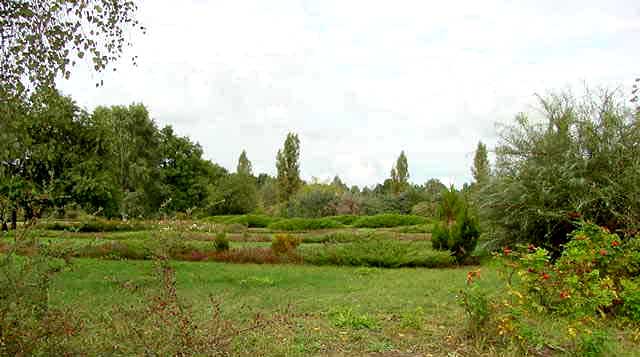Mass Graves at Sachsenhausen According to the files released by the Soviet Union, a total of approximately 60,000 German prisoners were held in the Sachsenhausen Special Camp No. 7 after World War II ended. The bodies of approximately 12,000 prisoners who died of starvation and disease were buried in unmarked mass graves in three locations: the Commandant's Yard in the front of the north exit of the Memorial Site, on the dunes on Schmachtenhagener Street, and in the Schmachtenhagener Forest on highway B 273 between Oranienburg and Schmachtenhagen. The photograph above shows the mass graves near the north exit of the Sachsenhausen Memorial Site. This area can be accessed by a revolving gate at the north exit, but there is no re-entry. Visitors who leave the Memorial Site to see the graves must return to the parking lot by means of a road that runs along the west side of the former camp. The photograph below shows the graves in the Schmachtenhagener Forest.  The following quote is from a brochure available at the Sachsenhausen Memorial Site: A total of at least 12,000 prisoners of the Special Camp in Sachsenhausen died from the conditions of their imprisonment, from disease and chronic undernourishment. During the harsh winter of 1945-46, when the already insufficient food rations were again halved, prisoners died in masses. The dead were hastily buried, naked and without identification, in mass graves in the surrounding area of the camp. Because every form of contact with the outside world was strictly forbidden, particularly receiving news from relatives, the Special Camp was often referred to as the 'Camp of Silence.' After the camp's closing was propagandistically reported in the press in the spring of 1950, it was not permissible to speak of the camps in the German Democratic Republic. Even in the west zones of occupation and later the Federal Republic of Germany - where organizations like the 'Fighting Group Against Inhumanity' and the 'East Offices' of the SPD and CDU had tried to procure and spread information about the 'Camps of Silence' - by the end of the cold war the camps were completely forgotten. Only after the breakdown of the Communist system in the G.D.R., when three mass graves of the Sachsenhausen Special Camp were discovered, did 'Stalin's camps in Germany' return to the public consciousness. Former prisoners spoke openly about their memories and placed a memorial stone on the northeast camp wall in 1990. Special Camp No. 7Table of ContentsHome |